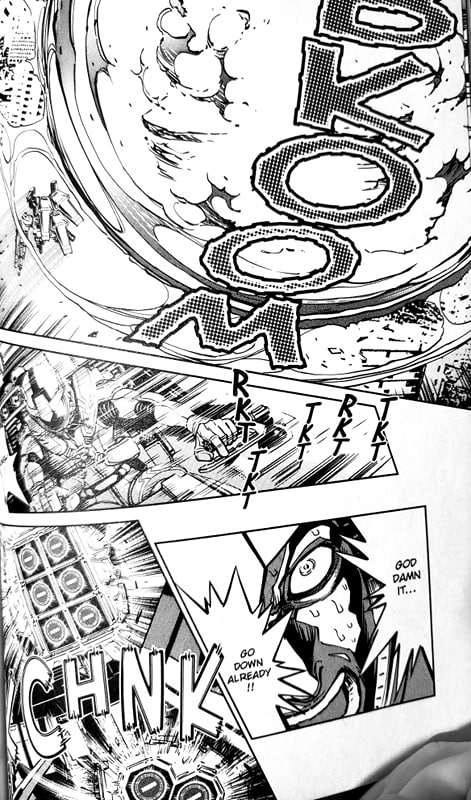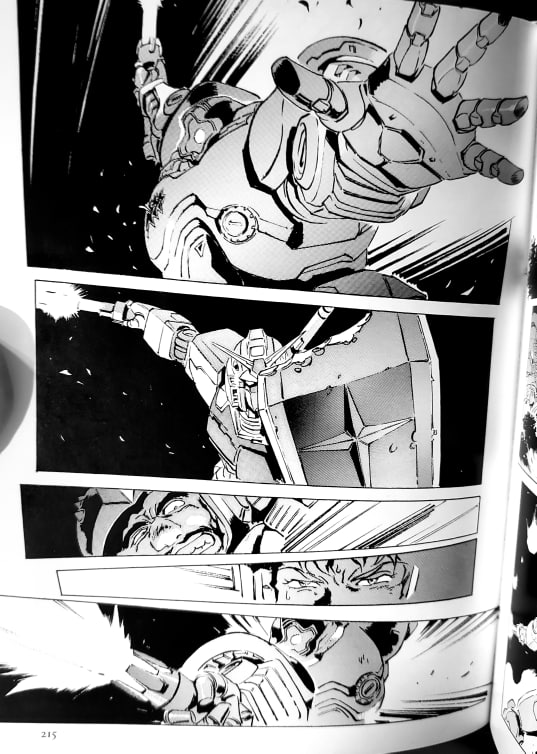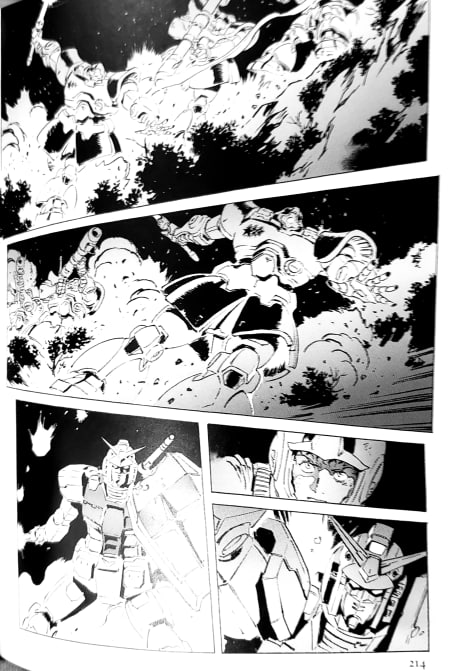As the next comic I am going to do is a mech comic, and as I’ve been basically immersed in mech comics and anime for the last year and a half, I thought I would share some of my thoughts and opinions on what I’ve seen in a series of articles. This article is mostly focused on mech combat. Some of these I really like, some less so. So without further ado (*note, since these are japanese comics, the pages read right to left not left to right*):
GUNDAM CROSSOVER NOTEBOOK 1
(Kazuhisa Kondo, Gundam Crossover Notebook 1)
I like how Kondo draws mechs. He has that kinda wirey crudded up design sense that Makato Kobayashi has with his mech comics. But I don’t really feel like the comic making aspect of these battles is that great. You can’t see it just from these two pages, but something he really overuses a lot is a shot of a mech getting torn apart from gunfire, and then the next panel is who is shooting. He does that a lot, which is kind of monotonous. I do really like the top right panel on the left page in terms of showing a mech taking damage. And I like the top three panels showing the Gouf on the right page, moving quickly across teh battlefield. But there’s not really a climax to that movement. The middle two panels on the left page are also really good for similar reasons. But the result of the movement and action is pretty cramped into the bottom quarter of the page, and you lose a lot of scale here which I think is a key component in making dynamic mech fights. You need to be able to know when to spin out and when to get in close, and when to cut away to the pilots for drama. Notice there aren’t any cutaways on these pages. Those cutaways really remind you of the emotions and skill that come behind what you are seeing.
FIVE STAR STORIES
(Mamoru Nagano, The Five Star Stories #7)
Nagano’s Five Star Stories shows what I’m talking about here. The middle panel on this page is rad, but it’s the top and bottom reaction panels that underscore it. And it’s only three panels, so there’s plenty of space. My issue with Nagano sometimes is that I actually can’t comprehend sometimes the movements his mechs are making, which I think is a deliberate choice on his part, but not one that I favor.
MOBILE SUIT GUNDAM THUNDERBOLT
(Yasuo Ohtagaki, Mobile Suit Gundam Thunderbolt vol 3 )
For me Yasuo Ohtagaki is the master of mech combat at this point. His action is clear, varied, and rooted in a core drama that enhances the action. I prefer a grimier mech in general than what he draws, but the nuts and bolts of his comic making are masterful. And I think he surpasses even Yaz in making mech seem huge, powerful, but also fast. I love we get this page of Io’s frustration and not being able to take out Daryl, and he unleashes on a full page all of these missiles, and then we have this spread of a backpedaling Daryl shooting down each missile, with him crying for joy in the bottom left panels of the spread. Almost every issue of Thunderbolt has something like this in it. If you want to learn the rhythm of how to make good mech fights, this would be the book I would recommend anyone reading.
KNIGHTS OF SIDONIA
Nihei is interesting, because his style is very much defined by scale, massive blasts, and the kind of minimalism that you would have always thought would work with a mech comic. Unfortunately most of Knights of Sidonia takes place in space, and I think that somewhat hamstrings how great and varied the fights could be. I think an underrated aspect in Mech anime, especially gundam, and in their manga, is that there are always three environments at least that we move between--earth, space, space colony. And each environment plays a role in the way things play out combat wise. Yaz is the master of that aspect. That said, nihei is no slouch, and his mech designs have a great balance of weird, grimey sharp edged brilliance. But note, how dramatic his scaleouts are. He’s not afraid to give a page over to them. He also does a pretty good job with pilot cutaways, as you see in both of these spreads.
(Tsutomu Nihei, Knights of Sidonia vol 5 and 6(read right to left))
NEON GENESIS EVANGELION
(Yoshiyuki Sadamoto, Neon Genesis Evangelion)
This was one of my favorite fights in the End of Evangelion anime. It’s so emotional and violent and cool, it’s probably the best fight in the eva series, and I just don’t feel like Sadamoto really captures it. While I do like his Evangelion comics, I don’t think his mech combat is especially notable. I think this suffers in a similar way to the Gundam Wing fights and the Kondo fights up above. Everything is too crammed together, and there’s not enough contrast really, or space. I also am not sure if these angular panels really work that well over and over for a fight. Think how much more of an impact that page where the 03 is dumping blood on itself would be if it was just two panels, and you could get a real sense of place of that top left panel? I don’t think the two small panels to the left of that do anything but rob the image of the space.
MOBILE SUIT GUNDAM THE ORIGIN
(Yoshikazu Yasuhiko, Mobile Suit Gundam The Origin IV)
Notice with all of these Yaz pages(sorry for the bad quality--the pages are glossy so hard to capture without glare), there are pilot reactions somewhere on every page. On top of that I think there are two areas where Yaz really hinges his strength as a master of the mech battle--the first is the humanity of his mechs. His mechs even though they are giant hunks of metal, the way they move mirrors the mindstate of their pilot. Look at the top left page, with the Dom with its fingers outstretched as it is about to swing at Amuro’s RX-78 unit and then the way the RX ducks behind the shield and the way that mirrors Amuro’s face in the panel below and his keen focus--it’s insanely good stuff. The other area that Yaz excels is placing his mechs in an enviroment. He really excels at landscapes, he just happens to have mechs that are in them. The best example on these pages is that panel in the top right where the doms are tearing down the side of that mountain with the trees and everything around them. But there are a lot of better examples elsewhere in the series. But it is interesting that you can say that for Yaz’s Gundam, they are formed by the two things least Gundam like, nature, and the humans within that nature. His mechs are the border between the two, and they largely come into being to the extent that they do, based around his manipulation of those two forces.
MOBILE SUIT GUNDAM WING ENDLESS WALTZ: GLORY OF THE LOSERS
(Katsuyuki Sumizawa and Tomofumi Ogasawara, Mobile Suit Gundam Wing Endless Waltz: Glory of the Losers vol. 6)
Lastly, from the Gundam Wing manga. I’m not really a fan of the manga battles in this comic. This is probably one of the better spreads, sadly. Again we see these angled panels and the struggle to fight the mechs within them. There’s also no real scale here, no weight, and your sense that these machines are even in the same space as each other is pretty minimal. It does have great dramatic dialog, which I think is also key for a good robot fight. People should be shouting their innermost turmoil in these kind of fights, to really make them sing and feel significant. Mech battles are at the top end philosophical trials of concepts between rival schools of thought, more than they are just battles. What stays with you is when these things actually mean something. Have some kind of screaming importance.
Anyways. If you enjoyed this article, and would like to read more like it, consider subscribing to my patreon in the link above.
-Sarah











